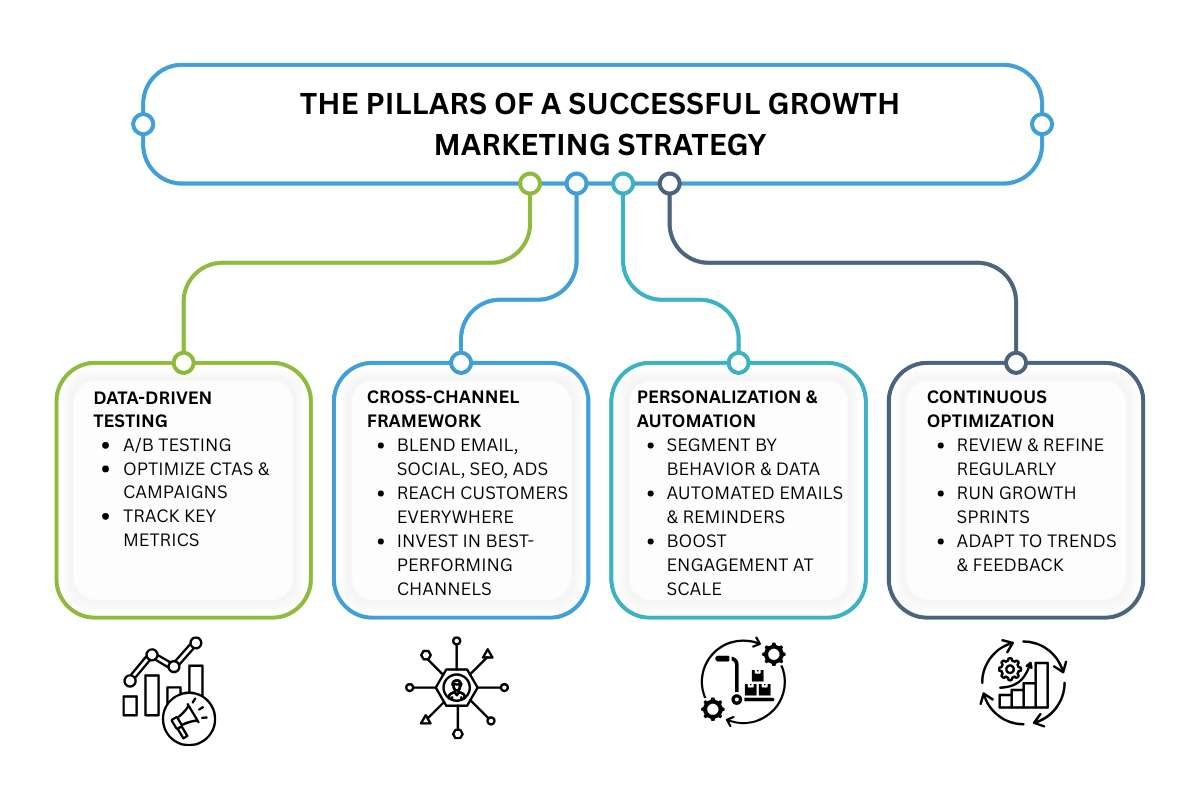Market development journey is as exciting as a roller coaster, but all fun, no whiplash! Think of your business as that one friend who tries every ride, wins every prize, and leaves with free popcorn.
That’s what this 2025 growth marketing strategy does for your results: it brings the action, motivates your team, and keeps everyone cheering till the finish line. Ready to leap past your competition and enjoy the thrill?
Let’s launch this strategy and ride the hilarious, high-speed wave to unstoppable business growth.
What is a Growth Marketing Strategy?
A growth marketing approach is a plan that uses rapid experimentation and modern digital tools to drive long-term business growth. Unlike traditional marketing, which might focus mostly on getting people in the door, a growth marketing strategy covers the full journey, from the first click to loyal customer status and beyond.
Why is this important in 2025?
Competition is up, attention spans are down, and one-size-fits-all tricks don’t work anymore. Market Strategy blends creativity, analysis, and technology to turn customers into active fans. Think of it as the ultimate recipe: data-driven testing, personalized messaging, and constant improvement lead to engagement and sales.
Key Fact: 83% of businesses now use a content marketing strategy as part of their growth marketing to drive engagement.
Why Your Business Needs a Growth Marketing Strategy in 2025?

Growth market development is essential for businesses of every size. In 2025, digital marketing spend will reach over $740 billion, with companies allocating bigger budgets to flexible, results-driven tactics. A growth marketing strategy lets brands capitalize on this shift by adapting fast, reaching new leads across many digital channels, and staying top-of-mind.
Personalized experiences, not mass-market campaigns, win hearts and wallets now. Customers want to feel special and seen. With a growth marketing approach, you can personalize every touchpoint using behavioral data and automation. Loyal customers buy more, share more, and stick around for the long haul.
Stat: 93% of website traffic now stems from search engines, and 86% of brands use video and automation as part of their growth market development for a reason: it works.
The Pillars of a Successful Growth Marketing Strategy
To build a winning growth marketing approach, focus on these four must-have pillars:
Here is a more detailed explanation of the four pillars of a successful marketing strategy, with clear examples and actionable insights.

Pillar 1 – Data-Driven Testing
Marketing strategy always starts with evidence, not assumptions. Data-driven testing means every campaign element, from headlines and CTAs to pricing and onboarding, is put through experiments. The most common method is A/B testing, where two versions are shown to separate groups to see what works best.
This approach helps teams optimize performance with real user behavior, not gut feeling. For instance, an e-commerce site boosted conversions by 18% simply by testing and updating its CTA from “Buy Now” to “Get Yours Today.” Tracking metrics like click-through rates or customer acquisition cost allows marketers to gradually refine every step of the customer journey and prove ROI.
Pillar 2 – Cross-Channel Framework
Growth Marketing approach avoids putting all marketing spend into one channel. Cross-channel means blending multiple platforms, such as email, social media, SEO, paid ads, and even physical events, so the brand meets customers wherever they go.
Each audience segment might prefer a different channel or touchpoint, so covering more touchpoints increases the odds of success. For example, while social media builds brand awareness, email nurtures leads, and SEO catches users searching for information. Marketers can track and compare results across platforms and invest more in what brings better engagement and conversions.
Pillar 3 – Personalization and Automation
Modern growth marketing strategy relies on customizing messages at scale. Personalization means segmenting customers by demographics, past purchases, and behavior, then sending offers or content that matter to each group. Automation enables this at scale by using marketing software to trigger emails, SMS, or in-app messages when users take specific actions.
For example, a welcome email series, birthday deals, and abandoned cart reminders are all automated and personalized based on customer data. Studies show companies using advanced personalization as part of their growth marketing development are 56% more likely to exceed their revenue goals.
Pillar 4 – Continuous Optimization
Market development is never a “set and forget” process. Continuous optimization means reviewing performance data regularly, analyzing what’s working or failing, and making consistent improvements. Campaigns are updated based on real-time feedback and evolving trends.
Teams hold iterative review meetings, sometimes called “growth sprints,” to discuss results, brainstorm new tests, and apply lessons learned. Brands that refine messaging, update creative assets, and reallocate budgets based on analytics achieve sustainable long-term gains, even as customer expectations and the market shift.
The Growth Marketing Funnel Framework

The growth marketing funnel covers every step of the customer journey. Unlike old-school funnels, growth marketing strategy doesn’t end at the first sale; it pushes for loyalty, referrals, and advocacy.
Key Stages of the Growth Marketing Funnel:
- Acquisition: Draw in new leads with irresistible offers, engaging content, and multi-channel outreach.
- Activation: Onboarding counts. Smooth introductions help users hit their “aha!” moment early, making them likely to stick.
- Retention: Use personalized offers, reminders, and value-driven messaging. A marketing strategy focuses on keeping users active and happy.
- Revenue: Up your sales with clever upsells, special deals, and habit-building features.
- Referral: Encourage sharing. A growth marketing incentivizes customers to refer friends and spread the word.
Fact: Companies using growth marketing to optimize onboarding have reduced churn by 22%.
Tools and Technologies for Growth Marketing Strategy
Modern tools make growth marketing development a breeze. Choosing the right stack lets teams combine creativity with data for huge growth. Must-Have Marketing Strategy Tools:
| Tool/Technology | Main Function |
| Zapier | Automates marketing experiments; connects over 3,000 apps |
| Hotjar | Visualizes user behavior with heatmaps |
| Looker Studio | Custom dashboards for reporting and analysis |
| Ahrefs & Semrush | Tracks SEO performance and optimizes content |
| Leadfeeder | Identifies real-time B2B site visitors |
| Optimizely & Userpilot | Powers A/B testing to refine strategy |
| Intercom | Manages customer conversations with bots and automation |
| Typeform & SurveyMonkey | Builds interactive forms and gathers campaign feedback |
| Amplitude & Mixpanel | Deep user analytics for campaign optimization |
Stat: 95% of marketers implementing personalization with growth tools rate their results as highly successful.
Common Mistakes to Avoid in Growth Marketing Strategy
Growth marketing works best without these pitfalls:
- Guessing Without Testing: Action without data gets expensive fast. Always test, then scale what proves out.
- Staying Stuck on One Channel: Marketing strategy thrives on agility. If you bet on one platform, you risk missing your audience elsewhere.
- Ignoring Personalization: Sending the same message to everyone alienates potential fans. A marketing strategy leverages data to personalize every step.
- Neglecting Customer Feedback: Users tell you through behavior (and sometimes words) what works. Growth marketing means listening, adapting, and acting fast.
Fact: Over half of customers (51%) unfollow brands that bombard them with irrelevant messages.
How to Build Your Own Growth Marketing Strategy?
To build your own growth marketing approach, first figure out who your customers really are and what you want to achieve, using actual data, not guesses. Next, plan every step your customer takes when interacting with your business so there are no missing pieces.
Then, get the right tools to help you test ideas, track results, and automate tasks. After that, try out small changes quickly, like new web pages or call-to-action buttons, and watch how they perform. Use what you learn to improve and grow what works, and stop what doesn’t. Finally, keep checking your progress often, because things change, and you want to stay ahead by adapting regularly.
Notable Case Studies and Real-World Facts
- Nike used a growth marketing strategy focused on affiliate engagement and women’s sports, netting a 42% year-on-year revenue bump and record engagement.
- Airbnb’s referral-based growth marketing strategy led to 300% sign-up growth in just one month.
Conclusion
This marketing strategy ride is only getting started! Like the roller coaster that made you laugh and want more, a growth marketing strategy makes each twist fun and every dip a setup for the next big climb. Keep your tests running, your feedback honest, and your data close. With the right tools, bold ideas, and real action, your business is set to claim all the best prizes, again and again.
FAQs
1. What’s the difference between Growth Marketing Strategy and traditional marketing?
Marketing strategy combines creative testing and data over the entire funnel, while traditional methods usually fixate on brand or lead generation.
2. What industries use Marketing Strategy?
Every sector, e-commerce, SaaS, retail, health, and more, leans on a growth marketing approach in 2025.
3. How soon do results show up?
Some optimizations pay off within days, but most growth marketing plans deliver 3-6 month compounding results.
4. Is Growth Marketing Strategy only for big budgets?
No, startups scale from small experiments. Results come from creativity, not always from spending.
5. What if a growth test fails?
Celebrate! Every failed test gets you closer to a winner. Marketing strategy is all about learning.


















